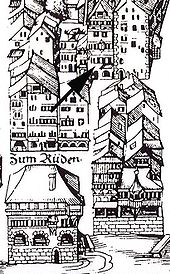Jos Murer

Jos Murer (* August or September 1530 in Zurich ; † October 14, 1580 in Winterthur ) was a Zurich glass painter , cartographer and playwright .
Jos (Jodocus) Murer was born in Zurich at the end of August or beginning of September 1530 as the son of Johannes Murer, who was naturalized from Grüningen in 1525 in Zurich, and was baptized in the Grossmünster on September 5, 1530 . His schooling was not the best, he could only attend a so-called "German" school. The higher educational establishments, where future clergy and scholars studied, were closed to him, but this did not prevent him from acquiring an impressive education.
Murer enjoyed a craft training and became a glass painter. The apprenticeship lasted three years at the time and was completed between 17 and 18 years of age. This was followed by a three-year wandering period and the master's examination, so that Murer may have become a master around 1550–1552.
In 1556 he married Barbara Schön, daughter of the carver Caspar Schön from Speyer . Before her marriage, she served as a maid in the household of Huldrych Zwingli's son . In the years 1557–1577, Murer repeatedly received fees for standing disks. In 1558, 1570 and 1579 Murer delivered disks of status and coat of arms in the cloister of the Cistercian monastery Wettingen , and in 1559 in that of the Cistercian monastery Tänikon .
However, he became even better known as a draftsman of many portraits of important personalities and as a woodcut illustrator.
His talent for drawing benefited him in his work as a cartographer, which he only did on the side. In 1566 a plan was drawn up for the entire Zurich area, a company that he apparently initiated at his own risk.
In 1576, in collaboration with Christoffel Froschauer the Younger , his plan for the city of Zurich was published. This is the famous Murer plan that hangs in countless private and public spaces in the city of Zurich today. It conveys the true image of medieval Zurich and is still used as a “key witness” when the original appearance of a building or an alley is to be determined. Murer's woodcuts are characterized by the lines reduced to the essentials and the parallel hatching. He succeeds in reproducing important things in a simplified manner without completely neglecting the detail. Murer was also able to prove his drawing skills as a glass painter .
In addition, Murer wrote a total of seven dramas: Naboth (around 1556); Besieging Babylon (1560); The Young Men’s Mirror (1560); Absolom (1565); Ufferstantnus Our Lords (1567); Hester (1567); Zorobabel (1575). In part, he decorated the works with small woodcuts.
Despite his fame, Murer was not a rich man throughout his life, although he owned the Zum Nägeli house on Rüdenplatz. He enjoyed great esteem in public and with the authorities. In 1578 he moved to Winterthur as a bailiff, where he died on October 14, 1580 at the age of 50.
Jos Murer's house, the Zum Nägeli house on Rüdenplatz, still stands today. On the corner of the house you can see the coats of arms of Murer and his wife along with the year 1565, above them a greeting, sword-bearing figure. It is conceivable that she is supposed to represent Murer himself, the similarity to his portrait is obvious.
Two of his twelve children, the sons of Josyas and Christoph Murer , also ran a glass painting business in Zurich.
literature
- Heidy Greco-Kaufmann: Jos Murer . In: Andreas Kotte (Ed.): Theater Lexikon der Schweiz . Volume 2, Chronos, Zurich 2005, ISBN 3-0340-0715-9 , p. 1295.
- Johann Rudolf Rahn , Jakob Baechtold : Murer, Jos . In: Allgemeine Deutsche Biographie (ADB). Volume 23, Duncker & Humblot, Leipzig 1886, p. 62.
- Peter Ukena: Murer, Jos. In: New German Biography (NDB). Volume 18, Duncker & Humblot, Berlin 1997, ISBN 3-428-00199-0 , pp. 607 f. ( Digitized version ).
Web links
- Literature by and about Jos Murer in the catalog of the German National Library
- Works by Jos Murer in the NEBIS catalog ( Zurich Central Library )
- Works by Jos Murer at Zeno.org .
- Arthur Dürst: Commentary on the canton map
- Barbara Giesicke / Mylène Ruoss: Murer, Jos (Jodocus). In: Sikart
| personal data | |
|---|---|
| SURNAME | Murer, Jos |
| ALTERNATIVE NAMES | Murer, Jodocus; Murer, Jost |
| BRIEF DESCRIPTION | Zurich glass painter, cartographer and playwright |
| DATE OF BIRTH | August 1530 or September 1530 |
| PLACE OF BIRTH | Zurich |
| DATE OF DEATH | October 14, 1580 |
| Place of death | Winterthur |



